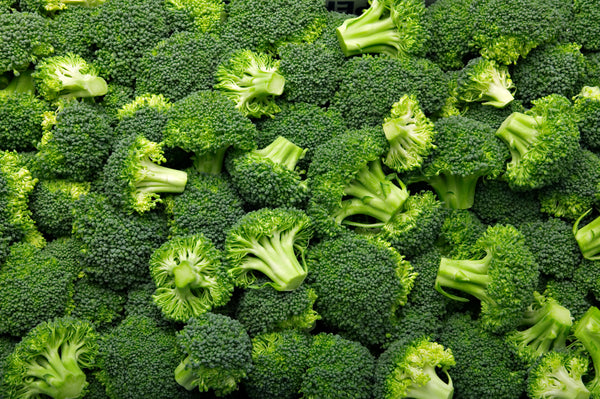Survival Soars With Sulforaphane: How This Broccoli-Based Antioxidant Extends Lifespan in Worms

Found in broccoli and other cruciferous vegetables like cabbage, kale, and Brussels sprouts, sulforaphane is a compound that supports health by acting as a potent antioxidant, participating in detoxification and supporting healthy glucose control. Previous research has found that adding sulforaphane-rich broccoli to the diets of red flour beetles extended their lifespans by 30%. However, as red flour beetles aren’t your typical lab subject, we don’t yet know if sulforaphane also boosts longevity in more common research animals like worms, flies, or mice — let alone humans.
Now, a research team from Germany revealed that sulforaphane could extend lifespan and improve various outcomes in worms. This work, published in the journal Aging, adds to the evidence of this compound’s species-wide benefits to health and longevity.
Broccoli pumps the brakes on aging
Sulforaphane’s anti-aging and health-promoting properties are mediated through several processes, including reducing levels of oxidative stress — the accumulation of inflammatory compounds called reactive oxygen species (ROS) that damage cells and DNA. Additionally, sulforaphane may act on longevity pathways by delaying cellular senescence, which is when cells irreversibly stop dividing and lose function but remain in the body, secreting inflammatory compounds to nearby tissues.
The broccoli-based compound also inhibits signaling pathways related to hormones called insulin-like growth factors (IGFs). Although certain IGFs, like IGF-1, are necessary for growth, metabolism, and maintaining skeletal muscle, too much of the hormone has been linked to serious disease development. In contrast, downregulation or inhibition of IGF-1 has been shown to increase lifespan in animal studies. However, human studies of IGF-1 levels and lifespan have been inconsistent and inconclusive — we don’t know yet if IGF-1 is, as a whole, helpful or harmful to health.
In this study, Qi and colleagues looked at the relationship between lifespan and IGF-1 pathways in Caenorhabditis elegans (C. elegans) worms. One gene thought to be involved in this process is DAF-2, which encodes the receptor for IGF-1. During the worms’ typical aging process, the DAF-2/IGF-1 pathway is active, which blocks the activity of another protein called DAF-16 that boosts the activity of approximately 100 genes related to longevity, antioxidant defense, and stress resistance. For these reasons, it’s thought that high DAF-2 and low DAF-16 activity is implicated in aging and disease. So, the research team aimed to determine if sulforaphane could inhibit DAF-2 (and its associated IGF-1), effectively boosting DAF-16 and its longevity- and antioxidant-related genes to increase lifespan in the worms.

Sulforaphane supports survival and stress resistance
First, the research team determined which of six different doses was the lowest effective dose needed to maximize lifespan. They found that 100 µM of sulforaphane per day (translating to approximately 50 mg/day in human equivalents) was their target dose, increasing the worms’ lives by 18.2%.
After figuring out the optimal dosage, Qi and colleagues administered sulforaphane treatment to the worms, which increased both their lifespans and healthspans — the amount of time lived without developing diseases or other health conditions. Specifically, sulforaphane increased lifespan by an average of 17%, boosted the worms’ mobility and appetite, and reduced accumulation of lipofuscin by 26%, a yellow-brown pigment that builds up in tissues and is considered a biomarker of ‘wear-and-tear’ aging.
Additionally, sulforaphane improved the worm’s oxidative stress resistance, which tends to decrease with age and contributes to poor health outcomes. After being exposed to juglone, a compound that promotes oxidation, 72% of the sulforaphane-treated worms survived after 24 hours, compared to just 31% in the control group.
The research team also looked at gene activity, finding that sulforaphane effectively inhibited the DAF-2 pathway. This allowed for DAF-16 to activate, inducing the activity of its genes related to longevity, antioxidants, and oxidative stress resistance. While it sounds promising that the inhibition of DAF-2 and the activation of DAF-16 are implicated in the sulforaphane-longevity relationship, the researchers wanted to be sure that there wasn’t another mechanism at play.
With that question in mind, Qi and colleagues took worms with inactive versions of specific genes that are downstream of DAF-2 but upstream of DAF-16. In these worms, sulforaphane treatment did not extend lifespan, indicating that the compound does promote longevity through the DAF-2/IGF-1/DAF-16 pathway.
Mom was right: Eat your broccoli
Although this study was done with worms, it does have potential implications for human health and longevity. The human equivalent to the worms’ DAF-16 gene is called FOXO, which acts just like DAF-16 in terms of increasing lifespan and fighting oxidative stress. With these genetic similarities, this study’s results indicate that sulforaphane’s beneficial effects on worms may translate to humans. As concluded by the authors, “Our study provides a promising hint regarding the suitability of sulforaphane as a new anti-aging drug. However, additional studies in invertebrates and mammalian model organisms are necessary to expand our findings”.
If you want to get your sulforaphane straight from the source, raw broccoli sprouts are the richest food source of the compound. These sprouts contain up to 100 times more sulforaphane than mature broccoli florets, at approximately 75 mg per ounce. However, if you’re still not listening to your mom and eating your broccoli, you’re in luck — sulforaphane supplements are also widely accessible and recognized as safe to consume.
References:
Grünwald S, Stellzig J, Adam IV, et al. Longevity in the red flour beetle Tribolium castaneum is enhanced by broccoli and depends on nrf-2, jnk-1 and foxo-1 homologous genes. Genes Nutr. 2013;8(5):439-448. doi:10.1007/s12263-012-0330-6
Qi Z, Ji H, Le M, et al. Sulforaphane promotes C. elegans longevity and healthspan via DAF-16/DAF-2 insulin/IGF-1 signaling [published online ahead of print, 2021 Jan 20]. Aging (Albany NY). 2021;13:10.18632/aging.202512. doi:10.18632/aging.202512
Vitale G, Pellegrino G, Vollery M, Hofland LJ. ROLE of IGF-1 System in the Modulation of Longevity: Controversies and New Insights From a Centenarians' Perspective. Front Endocrinol (Lausanne). 2019;10:27. Published 2019 Feb 1. doi:10.3389/fendo.2019.00027





